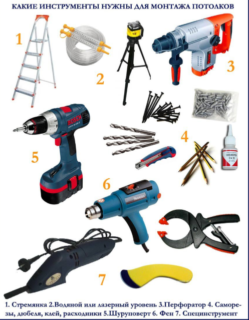If you want to change the interior of the room, it is absolutely not necessary to completely repair it. It is enough to install the stretch ceiling with your own hands. Its main advantage is the ease of installation, low cost compared to other finishing materials, and an increase in the speed of work. In this way, dirt can be avoided as no “wet” processes are required. However, some of the nuances of installation must be taken into account.
Types of stretch ceilings and their characteristics
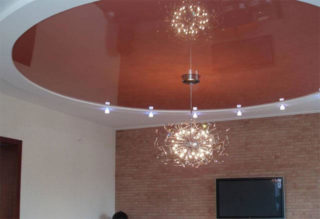
The technology for installing stretch ceilings depends on what material the structure is based on. Fabric and PVC products are considered popular.
Pvc
The PVC ceiling is welded, as it consists of several interconnected canvases. To mount the product, a heat gun is required, with the help of which the material is heated to a temperature of 60-70 ° C. In this case, the film is stretched and it can be easily fixed in the frame. After cooling, PVC stretches and becomes smooth. The product can be glossy or matte. Also in the assortment of films of different textures and colors. In one design, you can even use several canvases of similar shades.
You need to fix the ceiling so that the weld is perpendicular to the window. The material does not lend itself to the influence of chemicals, does not burn, and is able to hold a large volume of liquid. Thanks to the antistatic treatment, dust does not settle on the ceiling surface. The disadvantage of this type of material is its tendency to destruction when exposed to low temperatures, therefore it is not recommended to use it in unheated rooms.
Tissue
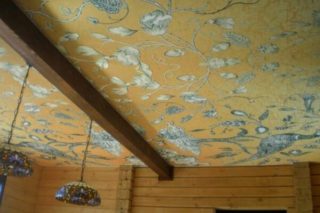
Fabric ceilings are seamless and are a lightweight mesh material that is impregnated with polyester during manufacture. The width of the panel can reach 5 m, so it is used in large office premises, restaurants, and public buildings. The fabric ceiling is capable of retaining cold and hot liquids.
To make the material resistant to moisture, it is coated with a special varnish. Polymers are used to change the color of the canvas. In addition, the fabric behaves well even in freezing temperatures. Since the material freely passes steam and does not interfere with air exchange, it can be installed in wooden houses. However, the cost of such a ceiling is high.
Despite the fact that the material is synthetic, it is absolutely safe for human health. A heat gun is not required to install the structure, since the product does not stretch and does not require heating the room.
There are many varieties of fabric ceilings: plain, color, for photo printing, acoustic. During the production of the canvas, various additives are introduced into its composition, making the material resistant to pollution and tear-resistant.
Advantages and disadvantages of stretch ceilings
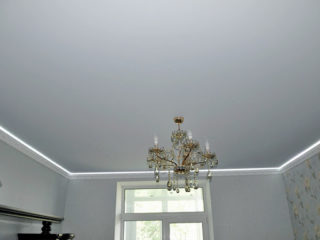
Materials for the manufacture of tension structures have the following general advantages over suspended ones:
- You can get a perfectly flat surface. The presented option is successfully used in those rooms in which there are large differences in the rough base in level.At the same time, there is no need to equip the lathing or frame, which takes away the height.
- Do-it-yourself installation of a stretch ceiling is much easier than building a plasterboard structure. The work is accompanied by less dust and debris.
- Long service life - at least 10 years. Even during the shrinkage of the house, damage does not appear on the ceiling.
- Flood protection. Water is simply collected inside the structure and easily pumped out.
- High degree of functionality. Under the canvas, you can hide the wiring, lighting, noise and heat insulation.
- Decorative appeal. Stretch ceilings can be plain and patterned.
- Visual expansion of space.
Like other structures, stretch ceilings have some disadvantages: they can be damaged by sharp objects. Despite the ease of installation, the master must have the skills to work with such material.
Measurements and necessary tools for work
Of the tools for work you will need:
- building level;
- laser level;
- ladder;
- puncher, screwdriver;
- heat gun with a gas cylinder;
- hammer, screwdriver;
- knife.
Dowels are used to fasten the profile. In addition to tools, you need to prepare all structural elements: a fixing profile (plastic or aluminum), self-tapping screws or dowels, a canvas.
To improve sound insulation, mineral wool is used, which is screwed to the rough ceiling with screws. For secure fixation, synthetic ropes are additionally used.
Ceiling preparation
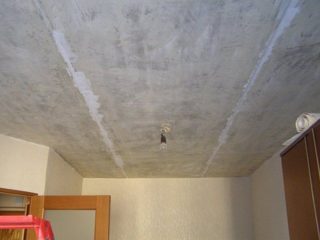
Before you can stretch the ceilings with your own hands, you need to prepare the room. All furniture that can deteriorate due to heating of the air is taken out of the room. Major wall and floor repairs must be completed. The vertical surfaces must be flat and the corners are straight.
Seams between ceiling tiles are cleaned of debris, fallen off plaster and sealed with polyurethane foam. The old finishing material is removed from the base and covered with a primer, which will prevent mold and mildew from developing. It is better to remove the plaster completely. At the preparation stage, you need to carry out the wiring for the lighting.
DIY installation instructions
First you need to correctly mark the walls. For this, the height is measured at all corners. When applying marks, the placement of the chandelier mount under the ceiling is taken into account. Using a laser level, lines are drawn around the entire perimeter of the room. It should be flat.
Fasteners are installed at a distance of 7-8 cm from each other. Sometimes, to prevent the profile from displacing from the applied line, it is first glued, and then screwed. The clips should not be attached too close to the edge.
Before installation, the canvas must be pulled evenly, warming up the room with a heat gun. Further work is carried out when the temperature in the room reaches 40 ° C.
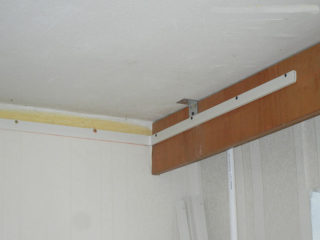
The following manipulations are carried out in stages:
- The material is removed from the packaging with dry, clean hands. It is spread on the floor, which must first be cleaned with a construction vacuum cleaner, washed and dried. It is better to remove all sharp objects, as they can damage the canvas.
- The canvas must be set to the base corner, and then to the opposite. The base warms up all the time. The same actions are performed with the remaining corners.
- The material is fixed with special crocodile fasteners. They are lined clips. They cannot damage the canvas.
- When treating the film with warm air, you need to remove the clamp and insert it into the baseboard with an angled spatula. This must be done carefully and slowly. Now you can go to another corner, but the canvas should be supported so that it does not jump out of the profile. The rest of the corners are fixed in the same way.
- You can start stretching the canvas in straight lines. To do this, use a straight blade that comes with the material. There is a seam on the canvas. It is fixed with 2-3 locks. Next, the canvas between the corners is divided into 2 parts and fixed in the center in the lock. The rest of the fragments are divided in the same way.
It will take just a day to assemble a stretch ceiling. Subject to the installation technology, the film will stretch without distortions.
Types of stretch ceiling fastening
Installation schemes and methods for attaching a stretch ceiling are different. You can assemble the structure using a harpoon, glazing bead or clip lock. Each type of attachment has its own characteristics.
Harpoon fasteners
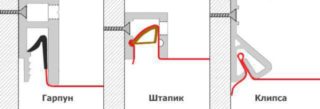
The device of a stretch ceiling with a harpoon mount is applicable if the material is PVC film. The constituent parts of the structure are:
- baguette;
- harpoon;
- cloth;
- decorative cornice.
An aluminum profile is used as a baguette. It is mounted around the perimeter of the room. A harpoon is a thin wedge-shaped plate. With its help, the film is attached. When taking measurements in this case, you need to be as accurate as possible, take into account all niches, protrusions. The blade and the spear are connected by welding.
The advantage of this method of fastening is that there is no need to control the tension and uniformity of the panel. The film is already cut strictly to the size of the room. Thanks to a special fixing system, the film adheres tightly to the walls. If necessary, such a ceiling can be completely or partially dismantled.
Since the film is securely fixed to the profile, the structure is capable of withstanding significant loads. the harpoon mounting method is used in large rooms, gyms, swimming pools. When installing the ceiling, sagging is not formed.
Shtapikovy fasteners
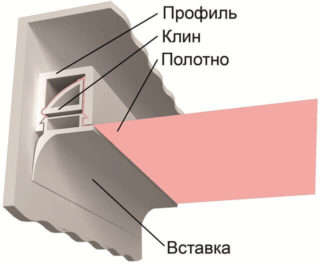
To make a stretch ceiling using the glazing method, you need a U-shaped aluminum profile. A wooden glazing bead is required, with which the canvas is clamped. The presented mounting scheme is relatively cheap, therefore more popular. The disadvantage of this method is the possibility of the glazing bead jumping out of the groove. It takes experience to firmly and correctly fix the film.
The advantage of this mounting method is that accurate measurements are not required. After fixing the canvas, its excess parts are simply cut off. It is advisable to buy a film that is larger than the base area.
Installation is simple: a baguette is screwed around the perimeter of the room. The room itself needs to be warmed up to 60 ° C. The product is fixed in the corners, after which they begin to pull it. The canvas must be stretched correctly to avoid the appearance of waves, wrinkles and other defects. Since after completing the work, a technological gap remains between the wall and the canvas, it can be closed with a plinth.
A feature of the glazing method of fastening is the impossibility of careful dismantling of the structure. If it gets damaged, you will have to change it. In addition, over time, the fastenings weaken and the ceiling can sag.
Clip fasteners
Fixing with clips is suitable for fabrics. They are attached to plastic baguettes. This installation method is not suitable for PVC films. The advantage of the method is that the room does not need to be heated. The fabric is simply inserted into the baguette and clamped with a clip. Fasten the canvas from the center of the wall towards the corners.
You do not need to use a cornice or masking tape, since there are no technological gaps after installing the ceiling.

